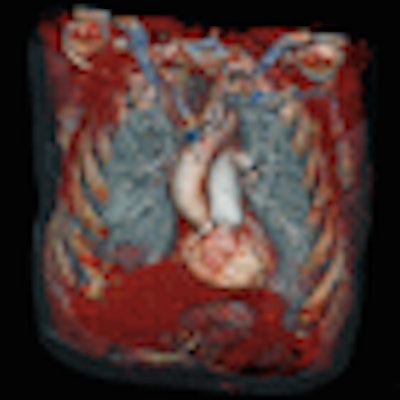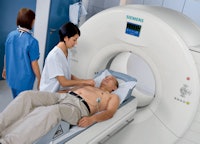
Multimodality vendor Siemens Healthcare today launched Somatom Definition Flash, a new multislice CT scanner that represents the second generation of the vendor's dual-source CT technology. The new system offers a number of benefits, according to the company, including the prospect of coronary CT angiography (CTA) exams at less than 1 mSv of radiation dose.
 |
| Siemens expanded the detector size on its new Definition Flash scanner. Image courtesy of Siemens. |
The benefits of the dual-source design range from faster cardiac scans, because twice as much data are collected with each gantry rotation, to improved dual-energy imaging, in which each x-ray tube operates at a different energy level, which can help differentiate between different types of tissue. Siemens has installed over 400 Definition Dual Source systems since the product began shipping in August 2006.
Definition Flash takes the dual-source concept and improves upon it in a number of areas, according to André Hartung, vice president of marketing and sales in Siemens' CT business unit. For one, Siemens has boosted the power of the scanner, as well as the gantry rotation speed, which now stands at 0.28 seconds, versus 0.33 seconds for the previous model.
But perhaps most significantly, Siemens has widened the size of the second x-ray detector to improve the system's functionality. With the first-generation model, the scanner's first detector, which Siemens calls the A detector, had a width of 50 cm, compared with a width of 26 cm for the second detector, called the B detector. Now, the B detector has a width of 33 cm.
The narrower B detector had limited the functionality of the system, especially for larger patients, according to Hartung. With the new configuration, users can always have the entire patient anatomy in the scan field, he said. Siemens also increased the slice count of the system, from 2 x 64 detector rows on the first Definition to 2 x 128 detector rows on Definition Flash.
Other improvements include a new tin-based selective photon shield that blocks unnecessary low-energy photons of the high-energy x-ray tube spectrum. This reduces patient radiation dose to the level of any standard single 120-kV scan, and it also enables the separation of high-energy and low-energy x-ray spectra during dual-energy imaging. The shield ensures that dual-energy imaging can be conducted without additional radiation dose delivered to patients, which improves clinical applications such as the separation of arteries and bone.
"This scanner will be able to bring dual-energy into the clinical routine," Hartung said. "You'll get the best of both worlds in one scan with no dose penalty."
The new scanner also will include X-Care, a new Siemens dose-reduction technology that uses tube-side collimation to adapt the x-ray beam to the area being scanned, and turns it off in areas that aren't necessary for the image. X-Care initially is only available on Definition Flash.
Better cardiac imaging
The new architecture also offers improvements in cardiac imaging, currently the hottest CT application. The faster rotation time enables cardiac scans to be conducted with a minimum temporal resolution of 75 msec, compared to 83 msec on the previous model.
Siemens is also touting a new Flash scanning mode for the system, which uses the fast gantry rotation time in conjunction with a high table pitch. Most single-source scanners have a table pitch of less than 1.5; higher than that and there are "data holes" that appear due to the faster movement of the table though the scanner aperture, Hartung said. Definition Flash, however, can operate with a table pitch as high as 3.2 (equivalent to a table feed of 43 cm/sec) thanks to its dual-source design.
With such a high pitch, Definition Flash can acquire cardiac images in a quarter of a heartbeat, or 250 msec in a single diastolic phase, compared to scanners that may require several cardiac cycles for image acquisition, eliminating the additional radiation dose from overlapping slices. Users can employ the system in either gated spiral mode or sequential mode, Hartung said.
This results in a radiation dose of less than 1 mSv for coronary CTA, he said. For a triple rule-out exam -- performed to rule out coronary artery disease, pulmonary embolism, or aortic dissection in patients presenting with chest pain -- the system delivers a dose of less than 5 mSv, compared with 15-20 mSv for conventional technology.
 |
| Definition Flash can perform triple rule-out exams in less than 1 second, at a radiation dose less than 5 mSv. Image courtesy of Siemens. |
Siemens will officially launch Definition Flash at next week's RSNA meeting in Chicago and expects to place the first systems at luminary sites starting in February 2009. The first two U.S. installations will be the Mayo Clinic in Rochester, MN, and Johns Hopkins University in Baltimore. The company hopes to begin commercial deliveries in the summer of 2009.
And how much will the new scanner cost? Siemens says it will carry a list price comparable to other super-premium multislice CT scanners, such as Aquilion One from Toshiba America Medical Systems of Tustin, CA, and the LightSpeed CT750 HD scanner from GE Healthcare of Chalfont St. Giles, U.K.
Does Siemens anticipate having trouble selling such an expensive new technology in an era of tighter capital budgets and more difficult access to financing? With respect to the financing, the company points out that Siemens maintains its own financing arm that can assist potential customers with purchases.
As for the cost, the company believes that in the end customers will come around if the technology delivers a clear clinical benefit.
"Hospitals might delay purchasing decisions, but at the end of the day they will have to make a purchasing decision," said Frank Sarfeld, global head of public relations and vice president of media relations for Siemens Healthcare. "You have to deliver a clear clinical benefit and not a certain technology. If you deliver a clear benefit the customer will believe you."
By Brian Casey
AuntMinnie.com staff writer
November 24, 2008
Related Reading
Siemens posts more revenue, less profit in Q4, November 13, 2008
Road to RSNA, Healthcare Informatics, Siemens Healthcare, November 10, 2008
Road to RSNA, Ultrasound, Siemens Healthcare, November 5, 2008
Road to RSNA, MRI, Siemens Healthcare, October 31, 2008
Siemens releases upgraded Soarian MedSuite, October 31, 2008
Copyright © 2008 AuntMinnie.com




















